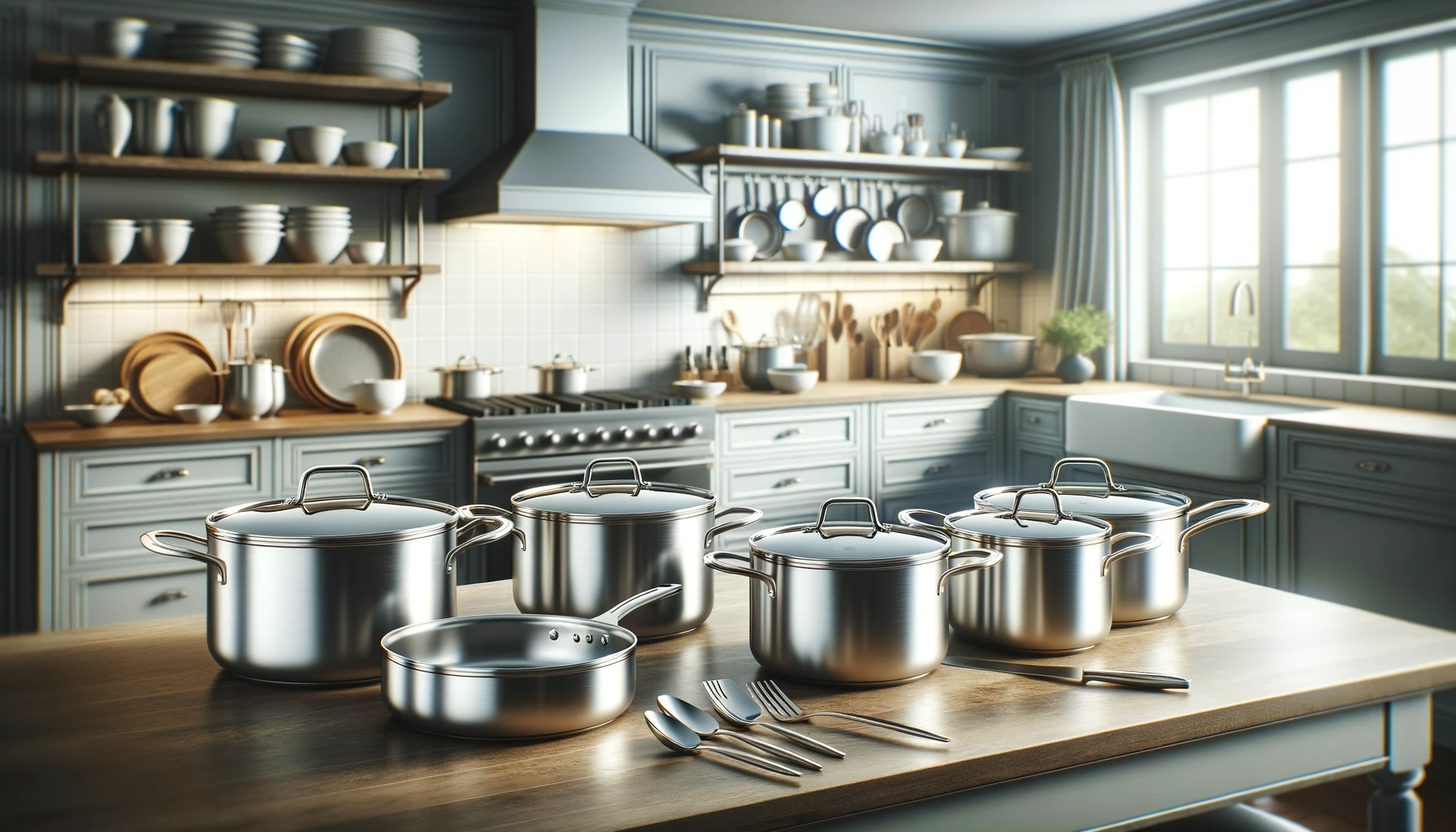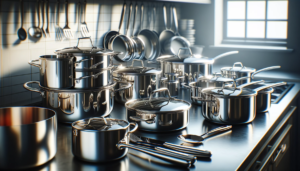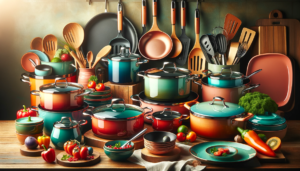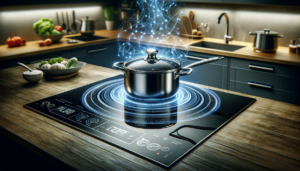Do your Calphalon stainless steel pots and pans fail to dazzle like they once did due to scratches, warping, and stains?
Caring properly for Calphalon cookware requires developing careful cleaning, storage, usage, and replacement habits.
Let’s dive into the top tips for keeping your stainless steel in pristine condition for over a decade.
How to Care for Calphalon Stainless Steel Cookware
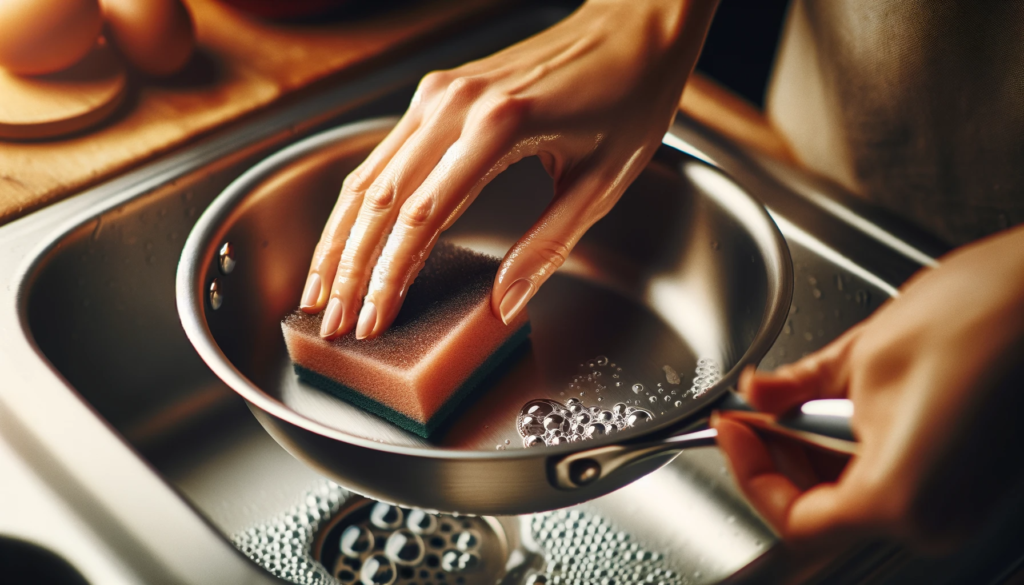
Caring for Calphalon stainless steel cookware requires properly cleaning, storing, using, and evaluating the pans.
Establish gentle handwashing, drying, and oiling habits after each use.
Allow cookware to fully cool before carefully nesting pieces with protective padding to prevent scratching.
Choose appropriate preheating and cooking temperatures when searing foods.
Deglaze and clean as soon as possible after cooking.
Regularly inspect for damage and replace pieces with excessive warping, rust spreading, or structurally loose handles and rivets.
With routine care and maintenance, your Calphalon stainless steel can reliably perform for over a decade.
Below we will explore each of these care and maintenance elements more fully, outlining best practices to keep your cookware looking brand new while maximizing functional longevity.
Proper Cleaning and Maintenance
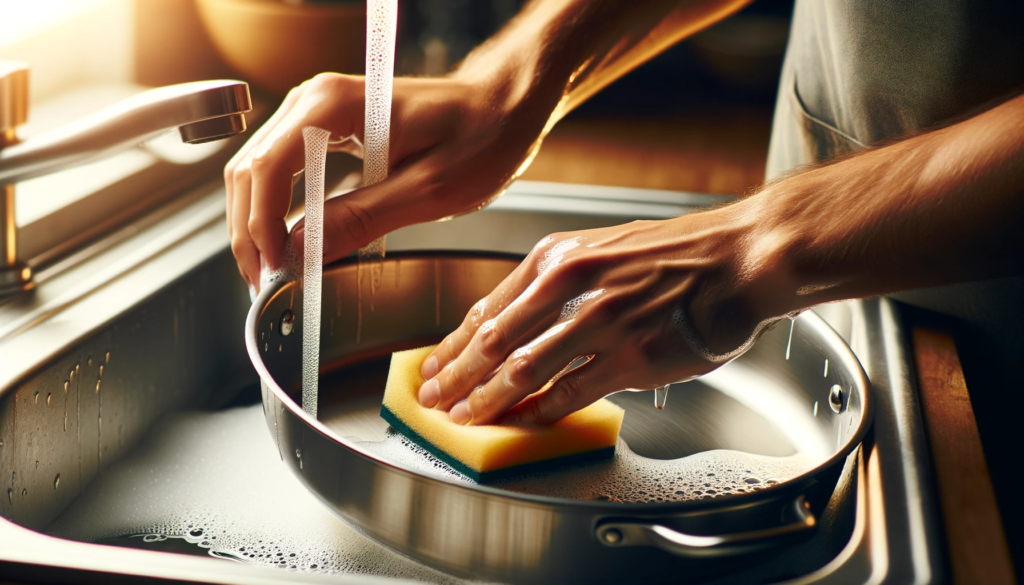
Caring for your Calphalon stainless steel pots and pans starts with proper cleaning and maintenance after every single use.
It is highly recommended that you wash the cookware by hand, using non-abrasive cleaners, in order to prevent scratches over time.
You can use the dishwasher to clean the pans but handwashing is much gentler on the surface and will extend the life of your investment.
When handwashing, use soft sponges or cloths to gently scrub the surface after cooking.
Do not use anything even mildly abrasive that could cause minor scratches to accumulate.
Steel wool pads and some nylon scrubbing pads are too harsh.
Stick to soft cloths, gentle sponges designed for nonstick pans, or soft brush bristles.
Wash with hot soapy water, using a mild detergent or basic dish soap.
After washing, thoroughly rinse the cookware under clean running water while wiping away any visible debris.
Visually inspect the surface as you rinse.
Once rinsed, immediately dry the pots and pans completely using a fresh, soft towel.
Allowing water droplets to air dry can lead to mineral deposits and corrosion over many uses.
It is crucial to ensure the cookware is completely dry before storing.
Pay special attention to handles and around rivets where water can hide.
Apply a small amount of cooking oil occasionally to the cooking surface after drying.
Choose a high smoke point neutral oil like canola, grapeseed, or avocado.
Lightly rub the oil across the entire surface using a soft cloth or paper towel.
This will provide a protective barrier preventing air from reaching and corroding the stainless steel.
Treat your new pans within the first month and re-apply every few months for optimal results.
Establishing proper cleaning habits after each use along with routine seasoning will help your Calphalon cookware maintain its beauty and function for many years before replacement is required.
Do not allow food debris or grime to build up by letting pans sit unwashed for long periods.
Clean as soon as possible after cooking while food is fresh.
Storing to Prevent Damage
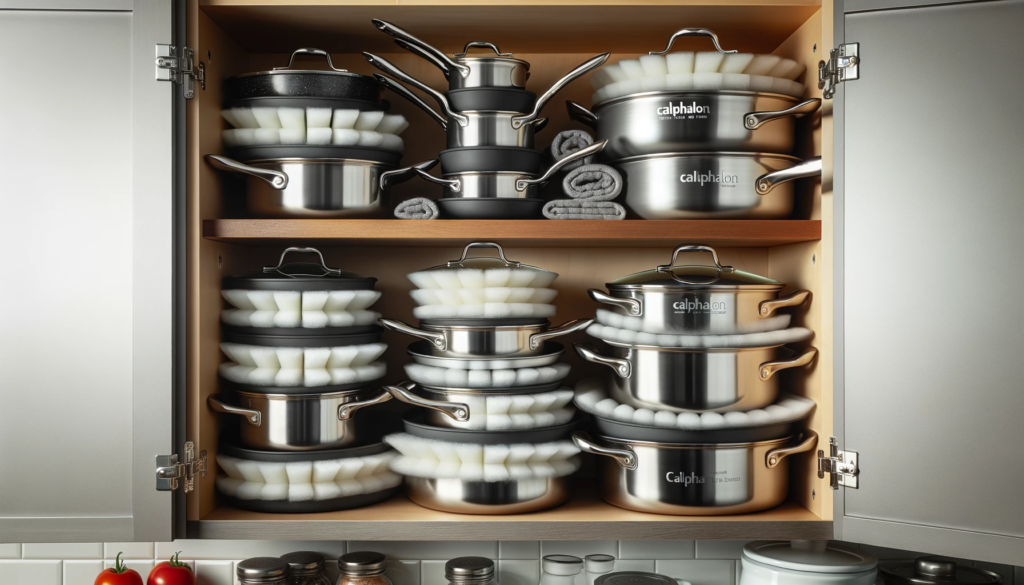
In addition to post-use care, properly storing Calphalon stainless steel cookware between uses is also very important for preventing unnecessary damage.
How and where you store pans impacts their longevity and functionality when not actively being used during food preparation.
The first rule is to always allow cookware ample time to completely cool prior to putting it away in storage between uses.
While stainless steel itself does not conduct heat very rapidly, ingredients with high fat or sugar content can cause food debris and residues to spread and harden as a pan cools.
Allowing pans to cool fully prevents further residue spread and allows safer handling before cleaning.
More importantly, putting away extremely hot pans into tight spaces or enclosed cabinets can create an environment for warping and distortion over time from inconsistent or extreme temperature changes during the cooling process.
Once completely cooled, carefully nest the pans without allowing the surfaces to harshly grind against one another which can lead to superficial scratches.
If possible, buy nesting cookware specifically fitted to properly stack together without damage.
If your particular pans did not come with designated nesting lids or stacking inserts, use pan protectors made of soft materials that can serve as buffers between pans.
Example materials include silicone, lambswool, and even paper towels in a pinch.
If space allows, consider storing pans individually on open shelves rather than stacked tightly in drawers or cabinets.
If you must stack non-nesting stainless steel pans, always use separators between them and take precautions to prevent scratching.
Line the bottoms with towels or pan protectors and never stack more than four high while keeping the stack very stable.
Place heavier pans at the bottom for stability and lighter pans toward the top.
Scratches can allow food particles to collect in the grooves leading to more sticking over time.
They also negatively impact the visible aesthetics.
Properly store cookware stacks on secure shelving in a cool, dry place within your home.
Avoid uninsulated spaces that experience temperature extremes like hot garages or humid basements.
Consider designating a specific area or cabinet just for your Calphalon stainless steel pots and pans to prevent them banging around with other items.
Use organizers and racks to prevent tipping or sliding around.
Establishing smart storage habits will keep your Calphalon looking pristine and prevent damage from occurring when the pans are idle between active cooking uses.
Designate an appropriate space that allows ventilation and stable stacking while protecting from extreme external or internal environmental factors.
How to Prevent Sticking and Discoloration
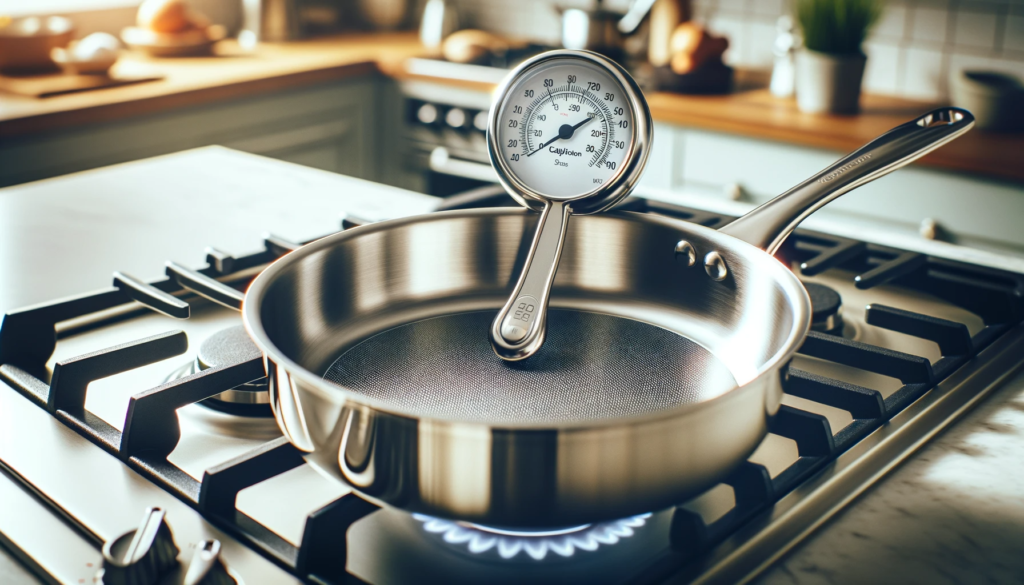
Calphalon stainless steel is naturally more stick resistant than other traditional cookware materials but sticking and staining can still occur under certain circumstances.
Luckily there are preventative measures you can take to avoid permanently scratched or discolored pans.
It starts with proper preheating every time before cooking.
Putting oil, butter, or other high-fat ingredients into a cold pan is just asking for stubborn sticking and nearly impossible scrubbing later.
Always properly preheat cookware over medium heat for at least one minute before adding any type of fat or other ingredients.
If anything starts to smoke excessively, the pan is too hot.
Properly preheating not only prevents sticking but also allows you to sear and caramelize ingredients rather than steam them.
Choose appropriate cooking temperatures and make adjustments based on variables like stove calibration and ingredients used.
If the level of heat is excessively high during cooking, food particles are more likely to quickly turn black and crispy leading to stubborn carbon buildup you’ll later have to scrub.
If the temperature is too low for too long during slow braising for example, sugars can slowly caramelize onto the pan bottom leading to discoloration.
Get to know your stove and find the right heat level sweet spot for different recipes.
Consider purchasing an inexpensive cooking surface thermometer to identify proper preheating and cooking temperatures if needed.
After preheating and cooking at efficient temperatures, avoid shocking hot pans by immediately rinsing them with cold tap water.
Allow them to cool for five minutes on the stove while still warm.
Then deglaze the pan by pouring in a small half cup of wine, stock, vinegar or water.
Use a wooden spoon or spatula to incorporate the liquid while scraping up any visibly stuck bits on the cooking surface.
Simmer the solution for 30 seconds which helps dissolve and loosen residues before they permanently bake onto the stainless steel and cause etching or pitting damage over time.
If accidents happen and food accidentally bakes onto the surface as you’re still learning your new stovetop, do not panic.
Simply cover the affected area with clean water before debris fully hardens and allow the pan to simmer for 10-15 minutes.
This should sufficiently rehydrate most stubborn debris so it wipes away easily without needing to aggressively scrub the delicate surface.
Gently scrub in circular motions only once softened but stop if resistance persists.
If stains remain, Bar Keepers Friend is a safe yet effective cleaning product specifically designed for stainless steel maintenance.
Occasionally treat the surface by gently rubbing Bar Keepers Friend over areas of discoloration using a damp sponge or soft cloth.
Let it sit for 2-3 minutes before rinsing and drying thoroughly.
The oxalic acid will help remove iron deposits, heat stains, and browned food discoloration without damaging the pan itself.
Repeat if needed for very stubborn stains that resist a single application.
Following these best practices will prevent the necessity for harsh scrub sponges that risk permanently marring the integrity of your Calphalon cookware.
Food is less likely to permanently bake onto the surface if you preheat properly, use appropriate cooking temperatures for ingredients used, deglaze frequently, and address cleaning promptly while food is still fresh and debris is hydrated.
But accidents still happen in busy kitchens.
Keeping Bar Keepers Friend on hand lets you easily refresh and restore the pristine brushed steel whenever minor stains occur.
When to Repair versus Replace
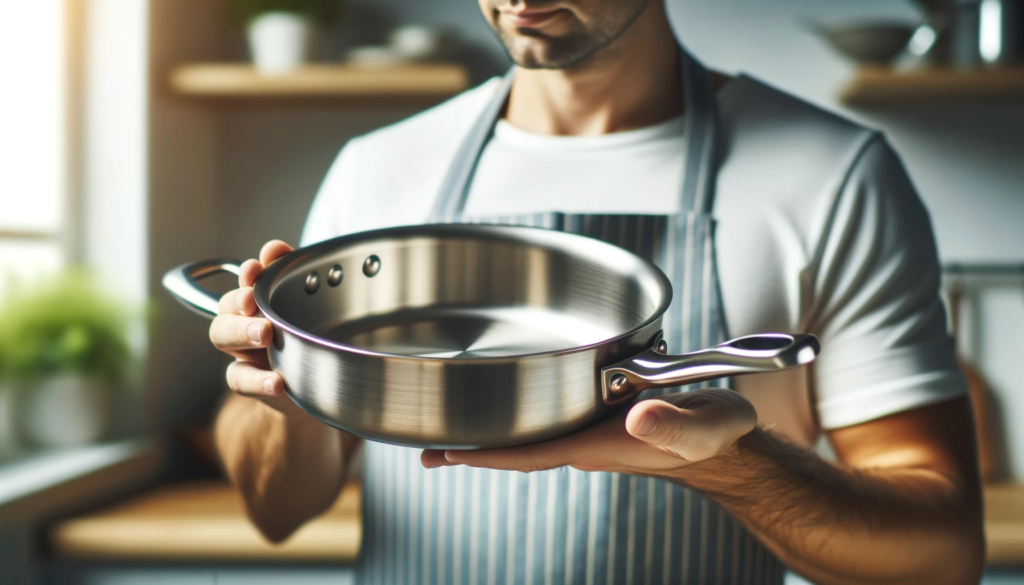
With proper preventative care and maintenance habits, Calphalon stainless steel cookware should last for upwards of ten years before replacement is warranted in most cases.
However, with continual daily wear and tear from repeated cooking and cleaning cycles, some damage is inevitable over time.
Knowing when to try repairing pieces versus replacing them is important for both safety and maximizing your return on investment.
Light surface scratches on the interior cooking surface or exterior sides are usually just cosmetic and do not impact safety or necessitate replacement.
But deep grooves, large dents, warping, corrosion spots, and compromised structural integrity due to repetitive overheating absolutely warrant replacement once they start seriously impacting cooking performance.
Extreme warping on the bottom of pots or pans allows instability resulting in uneven cooking results.
If a pan severely rocks, spins or generally does not make flush contact with stove heating elements, the structural integrity has likely been permanently impacted through overheating damage.
At this point the piece should be fully replaced or professionally repaired if emotional value merits the cost.
The appearance of new rust colored spots blooming underneath the top layers of brushed stainless steel are early indicators of corrosion setting in.
Try vigorously scrubbing just the affected area with steel wool to break through and remove the surface rust before it spreads deeper or wider.
Immediately re-season the abraded area to provide a protective barrier.
Monitor closely in subsequent weeks.
If rust continues spreading further across the cooking surface, replacement is necessary since once corrosion starts, the structural integrity of stainless steel is compromised.
If rivets or welding points come loose causing handles and lids to easily detach, replacement is not fully necessary.
Many reputable cookware manufacturers sell replacement parts so you can easily swap out just the broken handle or knob at a more affordable cost while still utilizing the majority of the original pans.
Contact Calphalon’s helpful customer service team to identify the appropriate replacement hardware kit for your particular cookware collection.
Carefully inspect each piece and only replace what cannot be more cost effectively repaired.
Conclusion
Caring for Calphalon stainless steel properly comes down to establishing smart cleaning, storage, cooking, and replacement habits.
With routine gentle care, your cookware can last over a decade before needing to be replaced.
But remember to always allow pans to cool before storing, use non-abrasive scrubbers, cook at appropriate temperatures, and inspect regularly for damage.
Investing a little extra time into caring for your Calphalon will ensure it reliably performs for years of delicious cooking ahead.
